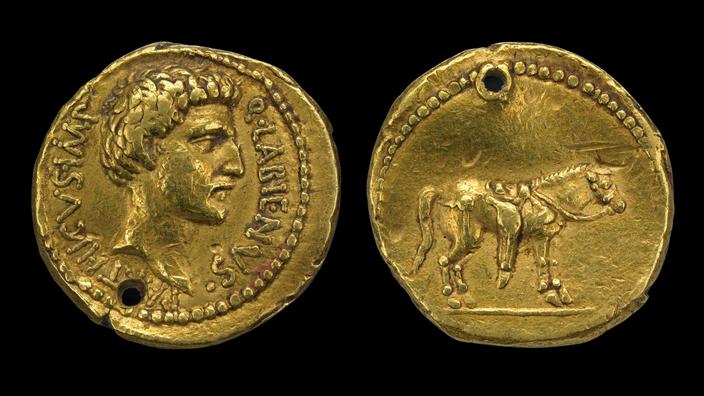Justice gave them back their coins.
Two men aged 66 and 48 were tried on Thursday January 6 for counterfeiting and complicity in counterfeiting at the Caen Criminal Court.
The object of their offense did not concern cigarette cartons or imitation leather goods, but antique coins.
Three Roman gold coins, to be precise.
Numismatic curiosities far from constituting a large and abundant treasure, like what archaeologists sometimes discover.
Except that the monetary type reproduced, extremely rare, was valued at 200,000 euros per unit during an expertise carried out three years ago by a specialist from the University of Caen.
Read alsoA fabulous treasure from the Roman era unearthed by a Spanish badger
“He wanted to turn gold into silver!”
, thus mocked during his indictment the prosecutor in charge of the case, according to our colleagues from the Actu.fr information site.
The two men judged in Caen had indeed enough to boil many numismatists with lust.
Their coins were beautiful reproductions of an
aureus
- a Roman gold coin - minted with the likeness of Quintus Labienus.
The Roman, was a general of the 1st century BC.
J.-C. and the son of Titus Labienus, right arm of Julius Caesar during the Gallic Wars.
Coins of extreme rarity
One of the last Republicans, he had led in 40 BC.
J.-C. an unfortunate campaign, from Parthia (part of present-day Iraq and Iran), against Roman Syria then governed by Marc Antoine.
The coins with the effigy of the general - decked out with his nickname Parthicus - were thus all issued during this expedition, either from one of the occupied cities, such as Antioch or Apamea, or from itinerant workshops.
In minute quantities, the
aurei
and
denarii
(silver coins) of Quintus Labienus are all adorned - on the reverse - with a harnessed horse in the Parthian style.
These coins are among the finest pieces in the collections that they honor with their presence, as in the British Museum.
Read alsoIn Cadiz, in the footsteps of the temple of Hercules Gaditanus, where Hannibal and Julius Caesar had gathered
Also, the appearance in Caen of such coins, in circumstances deemed doubtful, led to the opening of an investigation at the end of 2019, after an anonymous denunciation.
During the hearing, the 66-year-old man behind the copies said he had not sold any of the pieces in question, simply putting forward the track of a
“hobby”
.
"I had no particular project, it was experiments, I wanted to know how far we could go"
, did he declare. In 2019, during the expertise, the individual claimed to have acquired the object in Côte d'Ivoire, where he lives. The second man, an engraver from Bouches-du-Rhône, had been given the task of reproducing, with his equipment, the coins according to a photographic model. He pleaded that he did not know what his client intended to do with these ancient coins.
“I work with museums for reconstitutions, with collectors
, he defended himself at the beginning of the month.
I am a breeder so I make reproductions”.
Released for forgery, the 66-year-old man was found guilty of fraud.
He received a 12-month suspended prison sentence as well as a 5-year eligibility ban.
The matrices of the 48-year-old engraver, also released from the charge of counterfeiting, were confiscated.

